15 Free Podcast Editing Software to Upscale Audio

Anyone who has tried to record a podcast from home will know how difficult it can be to find the perfect noise-free setup. You’ve probably tried the old standbys - recording from a closet or under a blanket (the latter leaving you gasping for air and sweating profusely). Even if you turn off the AC, close all doors, and move away from windows, there are always going to be noises outside of your control, like the whir of a fridge or noisy neighbors.
Fortunately, good podcast editing software will let you edit, repair, and remove unwanted audio. The right software will make it sound like you dished out thousands of dollars to rent a recording studio - without paying a dime.
We’ve tested dozens of programs to bring you the 15 best free podcast editing software. Software that will not only fix bad audio, but upscale audio to sound as professional as possible. Keep reading below to find out which podcast editing software is right for you.
- Snapshot of Our Top 3 Free Podcast Editing Software
- How to Choose a Podcast Editing Software?
- 15 Best Free Podcast Editing Software to Upscale Recordings
- AudioDirector - Best Overall
- WavePad - Best for Batch Processing
- GoldWave - Best for Audio Effects
- Adobe Audition - Best for Professionals
- Podcastle - Best for Isolating Speech
- Sound Forge Pro - Best for Audio Mastering
- Descript - Best for Transcription
- Audacity - Best for Beginners
- Auphonic - Best AI Tools
- Hindenburg Pro - Best for Organization
- GarageBand - Best for Mac Users
- Alitu - Best Podcasting Community
- Waveform Free - Best for Professionals on a Budget
- Reaper - Best for Podcast Editing Remotely
- Fission - Best for Lossless Podcast Editing
- Best Free Podcast Editing Software Comparison Chart
- How to Edit a Podcast
- Download the Best Podcast Editing Software for Free
- Best Free Podcast Editing Software FAQ
Snapshot of Our Top 3 Free Podcast Editing Software
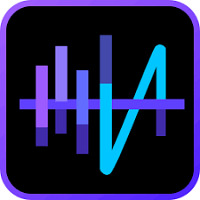
1. AudioDirector - Best Overall
AudioDirector is an all-in-one free podcast editing software that lets you record, edit, mix, and repair dialogue. It also comes with free music for podcast intros and outros, and sound effects to add fun. It is packed with advanced effects and tools that anyone can use, regardless of skill level. Detailed Review >

2. WavePad - Best for Batch Processing
WavePad is podcast editing software with a range of tools for beginners to advanced users. It is easy to use and offers batch-processing capabilities.

3. GoldWave - Best for Audio Effects
GoldWave offers tons of audio effects to add professional sound to your podcasts. GoldWave also has one-click tools and manual edits to cover a range of users.
How to Choose a Podcast Editing Software
- Ease of Use
- Price
- Features
- Automatic or Manual?
If you are thinking about starting a podcast, you probably have a lot on your plate. Tons of decisions to be made, equipment to buy, and episodes to be sketched out. Don’t add “learn how to use podcast editing software” to your list. Choose the right program for your skill set. We’ve listed the best options below ranging from first-timer to audio professional, and everything in between.
Don’t commit to spending money on podcast editing software until you know it’s the right fit. There are tons of free options available for you to try out. Some options on our list are free trials of more expensive software, others offer free versions with the chance to upgrade once you are ready, and some offer all tools and features completely free. Even if you have a large budget, there’s no reason to waste money on expensive podcast software if you don’t have to.
What are you using the software for? If you are getting software for podcasts only, skip one of the audio editors with tons of music production tools, as they tend to be more expensive and complicated to use. However, if you plan to edit audio for a variety of reasons, one of those programs might be best.
Also, think about which features are important to you. If you are a podcaster who records outside, or in public places, podcast editing software with background noise removal and audio restoration tools is more important than it is for someone who rents studio space.
You’ll notice many of the podcast editing software on our list have automated, one-click editing solutions. If you like to have more control over edits, you will need software for podcasts with manual adjustments. Some of the choices on our list, like AudioDirector, offer AI-powered one-click options that can also be manually adjusted.
15 Best Free Podcast Editing Software to Upscale Recordings
1. AudioDirector - Best Overall

Compatibility: Windows
TechRadar Rating: 4/5
Audio Restoration Tools: 5/5
Price: Free
*Premium subscription available for $4.33/month
Key Features:
- Audio restoration/enhancement tools
- Batch processing
- Professional audio mixing
- Audio Ducking
Who It’s For
AudioDirector is a complete professional-grade audio mixing and production studio which allows you to not only record and trim your podcast, but also mix, clean, and add effects. With an intuitive set of tools and an approachable interface, it provides easy but powerful control over your podcast production, making it our #1 choice for podcast editing software.
Why We Picked It
Easily add sound effects or music from the large royalty-free stock library and remove unwanted vocals from songs to create a clean soundtrack or podcast intro. No matter where you record your podcast - at home, outside, or in a studio - AudioDirector has you covered with AI-powered audio restoration tools. These include the removal of wind, plosives, clicks, pops, crackles, distortion, hiss, and hum, as well as a background noise reduction tool.
Bottom Line
AudioDirector is the perfect mix of professional and beginner-friendly software, with a large and powerful set of tools that are easy enough for anyone to use. Add to that an affordable price tag, and you’ll see why AudioDirector is the best podcast editing software on our list.
Pros
- Intuitive and user-friendly interface
- Beginner-friendly
- Also available in a Director Suite with video and photo editing software
Cons
- Currently only available on Windows
Click the button below to try AudioDirector for free today and start making your podcast dreams a reality.
2. WavePad - Best for Batch Processing
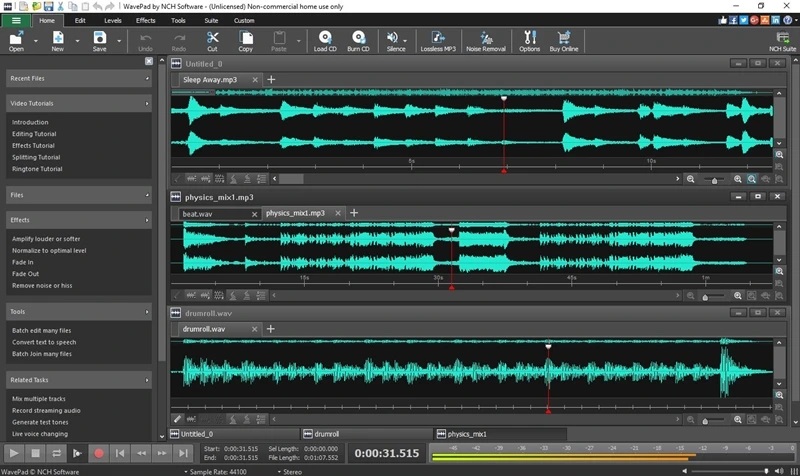
Compatibility: Windows, Mac
G2 Rating: 4.4/5
Audio Restoration Tools: 4.5/5
Price: Free
*Premium versions available for $60 for Standard and $99 for Master
Key Features:
- Scrub, search, and bookmark audio
- Music and sound effect library
- Non-destructive editing
- Create ringtone
Who It’s For
WavePad is a free podcast editing software for beginner and professional audio editors. We love WavePad for its batch-processing capabilities. Users can apply effects or convert thousands of files in one go with this audio editor.
Why We Picked It
Use WavePad to make basic edits such as cut, copy, paste, insert, auto-trim, and more. Or try out advanced features like spectral analysis, speech synthesis, and voice changer. There are also audio restoration tools such as noise reduction and click/pop removal, and audio effects like amplify, reverb, echo, and reverse.
Bottom Line
We found WavePad to be the closest match to our #1 software for podcasts, AudioDirector. They both have a robust toolset of basic and advanced features, are easy to use, and have free and paid versions of their podcast editing software. But while AudioDirector offers lightning-fast processing, WavePad is incredibly slow. We found it took WavePad up to 30 minutes to apply one effect.
Pros
- Wide format support
- Lots of basic and advanced tools
Cons
- Slow effects processing
- Free version not for commercial use
3. GoldWave - Best for Audio Effects
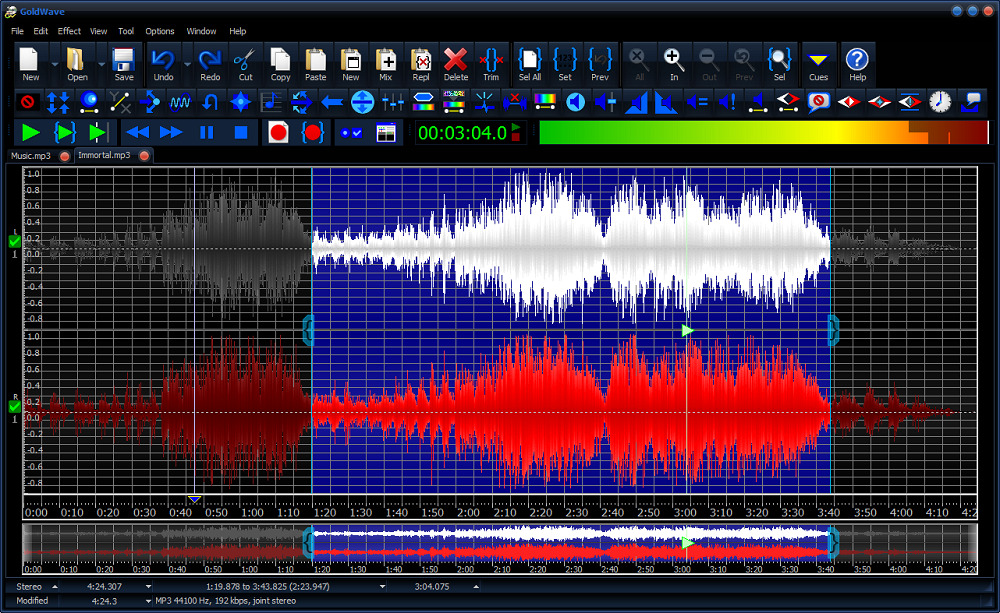
Image from GoldWave
Compatibility: Windows
G2 Rating: 4.4/5
Audio Restoration Tools: 4/5
Price: 30-day free trial, then $19/year or $59 for a lifetime license
Key Features:
- Batch processing
- Cut/Copy/Paste/Trim audio
- Voice changer
- Effect chain editor
Who It’s For
GoldWave is podcast editing software for anyone who frequently uses audio effects in their podcasts. There are over 40 different audio effects to use in your podcast editing. Most effects are easily applied using presets, and you can preview all effects in real time. Effects include echoes, reverbs, flangers, etc., plus a Censor button to bleep profanity.
Why We Picked It
This podcast editing software has a range of tools for beginners to advanced audio editors. Some tools offer precise control, such as the Spectrum Filter and Equalizer, while Auto Gain and Noise Reduction tools can be applied in one click.
Bottom Line
GoldWave has a very affordable paid version, but its former free version has been changed to a temporary free trial. And while it does have some advanced tools, its lack of multi-track editing will put off experienced audio editors.
Pros
- Full keyboard accessibility
- Tools for beginners and pros
Cons
- Doesn’t offer multi-track editing
- Outdated UI
4. Adobe Audition - Best for Professionals
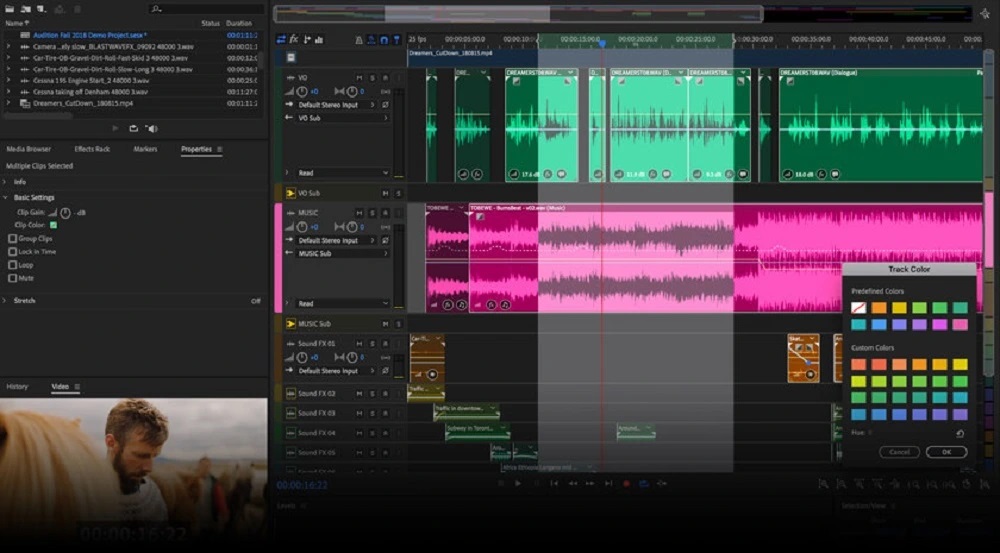
Image from Adobe Audition.
Compatibility: Windows, Mac
PCMag Rating: 3.5/5
Audio Restoration Tools: 5/5
Price: 7-day free trial, then $20.99/month
Key Features:
- Non-Destructive audio editing
- 128 Audio tracks
- Auto-fit background music
- 10,000+ sound effects library
Who It’s For
Adobe Audition is one of the best digital audio workstations around. This is the best podcast editing software for professional use because it is packed with features, but takes a professional’s skill to operate. Audition is often used by professional sound engineers to record, clean, and restore audio for TV and film. It also has a Loudness Meter to make sure all media complies with podcast loudness standards worldwide.
Why We Picked It
We found this software is ideal for editing sound in podcasts and videos. Audition supports multiple audio file types and comes with advanced editing tools like audio ducking, background noise reduction, de-reverb/denoise tools, and a sound remover tool. The Strip Silence feature cleans up the sound in podcasts and interviews and compensates for uneven volume.
Bottom Line
Audition is for audio and sound design specifically and lacks complex music production tools that are unnecessary for podcast editing. But even without the music tools getting in the way, Audition still has a steep learning curve. While AudioDirector is both beginner and budget-friendly, Adobe Audition is neither, with only a 7-day free trial.
Pros
- Works with other Adobe products like Premiere Pro
- Option to save frequently used actions and keep them a click away
Cons
- Expensive after free trial
- Steep learning curve
5. Podcastle - Best for Isolating Speech
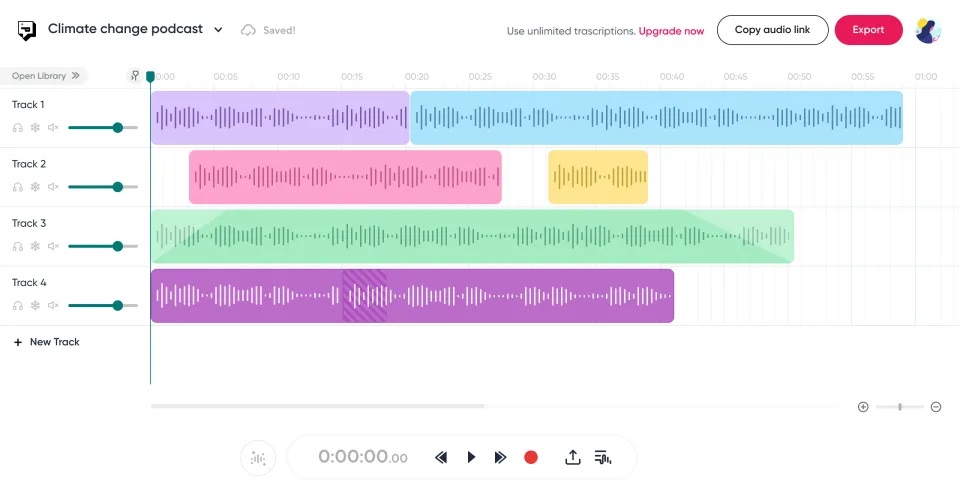
Image from Podcastle.
Compatibility: Web Browser
Product Hunt Rating: 3.8/5
Audio Restoration Tools: 4.5/5
Price: Free
*Premium subscriptions available for $11.99/month for Storyteller, or $23.99/month for Pro
Key Features:
- Royalty-Free music and sound effects library
- Silence removal
- Realistic voice skins
- Transitions
Who It’s For
Podcastle is a quick and user-friendly podcast editing software. It comes with AI tools that can isolate your voice so you can make it sound flawless. Use the compression tool to remove plosives, and remove background noise with Podcastle’s automatic noise cancellation tool. Individually adjust the levels and speed of your vocal tracks, music, and sound effects.
Why We Picked It
Podcastle is a hybrid of two other podcast editing software on our list - Alitu and Descript. It has the speed and user-friendliness of Alitu, with the transcription and text-to-speech tools of Descript. We found it has more features than both of the other podcast editing software.
Bottom Line
The podcast editing tools available in the free version of Podcastle are limited to only a few uses. After that, users will need to pay the monthly subscription which is more than double the cost of AudioDirector for the Storyteller version and more than 5 times the cost for Pro.
Pros
- Beginner-Friendly
- Excellent speech isolation, and text-to-speech tools
Cons
- Expensive monthly cost to access all features
- Laggy
6. Sound Forge Pro - Best for Audio Mastering
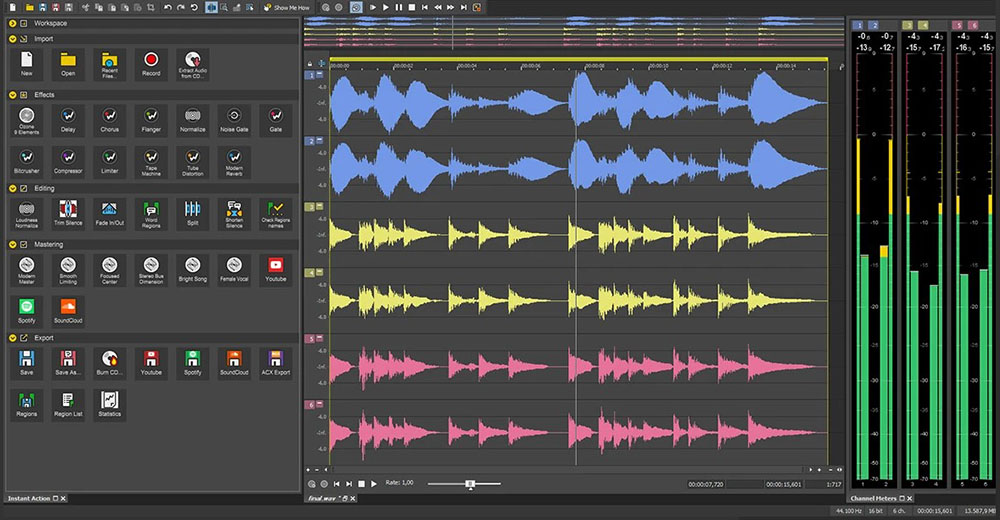
Image from Magix
Compatibility: Windows
G2 Rating: 4.3/5
Audio Restoration Tools: 4/5
Price: 30-day free trial, then $399
Key Features:
- Loudness visualization
- Multichannel workflow
- Plug-in manager
- Wide format support
Who It’s For
Sound Forge Pro is podcast editing software for professionals and the best editor for audio mastering. It offers many mastering tools, such as a 2-point compressor (most audio editors have only 1-point compression), a limiter that sets the maximum volume of an audio signal and won’t go any higher, an expander that suppresses noise and increases range, and a gate that suppresses quiet sections of the audio.
Why We Picked It
We like how many different ways you can master, edit, clean, and apply reverb with Sound Forge Pro. The podcast editing software offers a wide range of solutions for every problem. It also includes audio restoration tools such as a dehisser, declicker, decrackler, and declipper.
Bottom Line
Similar to Reaper, Sound Forge Pro is geared toward music producers and has a huge amount of effects that would never be used for podcast editing. But it does offer advanced audio editing and restoration tools, so if you are a podcaster who also happens to be a musician or music producer, this is the podcast editing software for you! Sound Forge Pro is constantly improving, however, because it is offered as a one-off purchase and not a subscription, users can only gain access to new features with paid upgrades - which inexplicably cost the same as buying the product for the first time.
Pros
- Fully customizable user interface
- Wide range of advanced tools
Cons
- Not for beginners
- Expensive after free trial
7. Descript - Best for Transcription
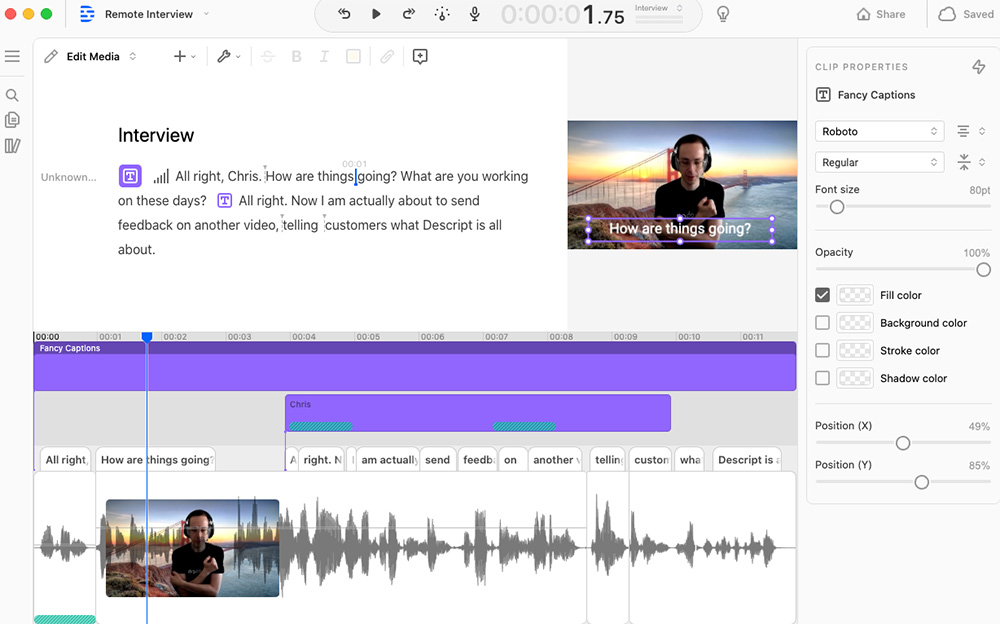
Image from nodalab
Compatibility: Web Browser
TechRadar Rating: 4.5/5
Audio Restoration Tools: 3.5/5
Price: Free for up to 2 hours of audio per month
*Premium subscriptions available for $12/month for Creator and $24/month for Pro
Key Features:
- Batch editing
- Mic bleed detection
- Audio ducking
- Cloud media library
Who It’s For
Descript is the perfect podcast editing software for beginners who are more comfortable editing written words than audio files. With the text-to-video editor, you can edit the transcription of your podcast, instead of the audio files. If you delete a word in the text, it will be automatically deleted from the audio (and vice-versa). You can also use Overdub to create a clone of your speech and fill in words you forgot to say when recording.
Why We Picked It
With this podcast editing software, you can shorten or lengthen the space between words and fill in the gaps with automatic room tone generation. Sound mixing tools include fades and crossfades, automatic leveling, and loudness normalization. It also includes one-click noise removal and some audio enhancement tools.
Bottom Line
Through our research, we found that Descript offers unique audio editing tools not found in other podcast editing software. Experienced audio editors will like that you still have the option to edit audio the old-fashioned way, but they might find the feature set too limiting. Also, the transcription tools are only available in English, and struggle to understand regional accents.
Pros
- Lots of options for metadata
- Beginner-Friendly
Cons
- Glitchy
- Transcription not always accurate and only in English
8. Audacity - Best for Beginners

Compatibility: Windows, Mac, Linux
PCMag Rating: 4/5
Audio Restoration Tools: 4/5
Price: Free
Key Features:
- Supports 16-bit, 24-bit, and 32-bit audio processing
- Support for effects plug-ins
- Automatic ducking
- Automatic crash recovery
Who It’s For
Audacity is the best free podcast editing software for beginners. While it doesn’t have many advanced features, it does have all the essential tools a new podcaster needs to edit audio. Audacity is simple to use - just drag and drop effects like echo, phaser, reverb, and distortion, then trim clips and save.
Why We Picked It
Audacity has audio restoration tools like noise reduction and reducing or isolating vocals. It also makes it easy to import, then cut, copy, paste, and delete your audio files. Editing is destructive, but you have unlimited Undo and Redo. You can export multiple files at once and choose from a variety of formats.
Bottom Line
Beginners will benefit from learning how to edit audio on an easy-to-use and free podcast editing software like Audacity before upgrading to something a little more robust. More seasoned podcasters will miss features like native plug-ins, a sound effects and music library, and real-time effects processing. You can find these missing tools in the software at the top of our list.
Pros
- Beginner-Friendly
- Completely free
Cons
- Effects are processed in real-time, so you can’t hear them while you record
- Destructive editing
9. Auphonic - Best AI Tools
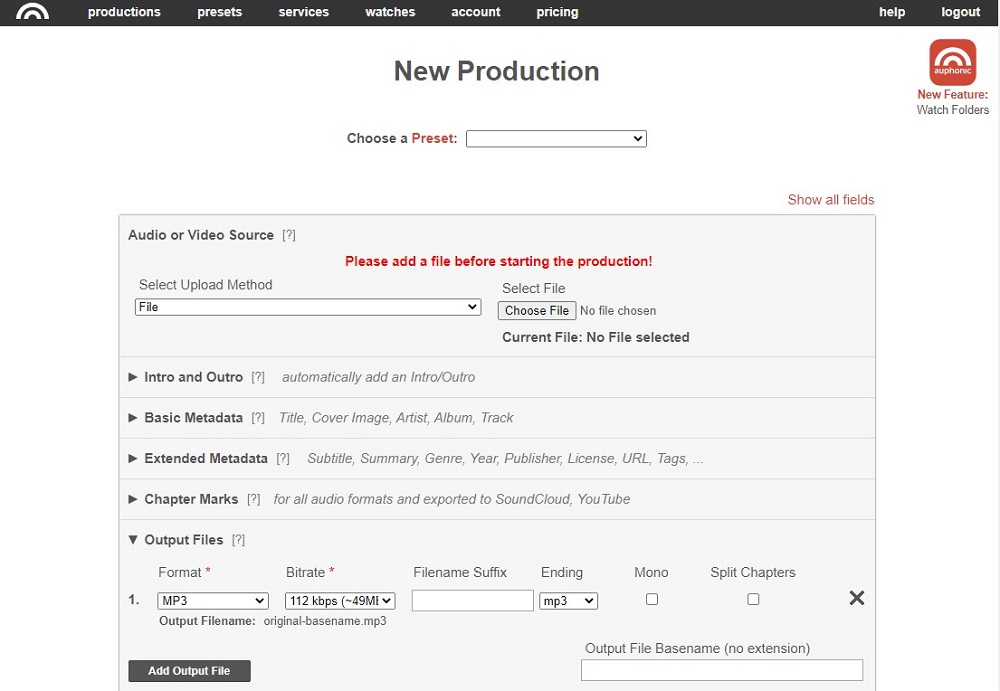
Compatibility: Web Browser
Cuspera Rating: 4.1/5
Audio Restoration Tools: 3.7/5
Price: Free for up to 2 hours of audio per month
*Monthly plans available by the hour ($11/month for 9 hours, $24/month for 21 hours, and so on)
Key Features:
- Loudness normalizer
- Cross talk removal
- Third-Party integration
- Low-Frequency filter
Who It’s For
Auphonic is a podcast editing software that uses AI-based audio algorithms to make automatic and professional-quality changes to your audio recordings. Auphonic has an intelligent leveler that automatically balances audio levels between different guests, auto noise and hum reduction, auto-ducking, and auto speech recognition and transcription in over 80 languages. All the automated tools make this free podcast software a good choice for beginners.
Why We Picked It
We found it easy to edit across multiple tracks simultaneously with Auphonic. This podcast editing software has wide input/output support, metadata, and chapter marks. Automatically send your content to popular podcast hosting sites, YouTube, Facebook, Dropbox, and more.
Bottom Line
Beginners and podcast editors in a hurry will love all of Auphonic’s automated features. However, more experienced podcasters won’t like the lack of control that comes with one-click solutions. If you want beginner-friendly podcast editing software that will grow with you, try AudioDirector or WavePad.
Pros
- Automatic audio editing for beginners
- Wide format support
Cons
- Lack of control over edits
- Monthly credits don’t roll over
10. Hindenburg Pro - Best for Organization
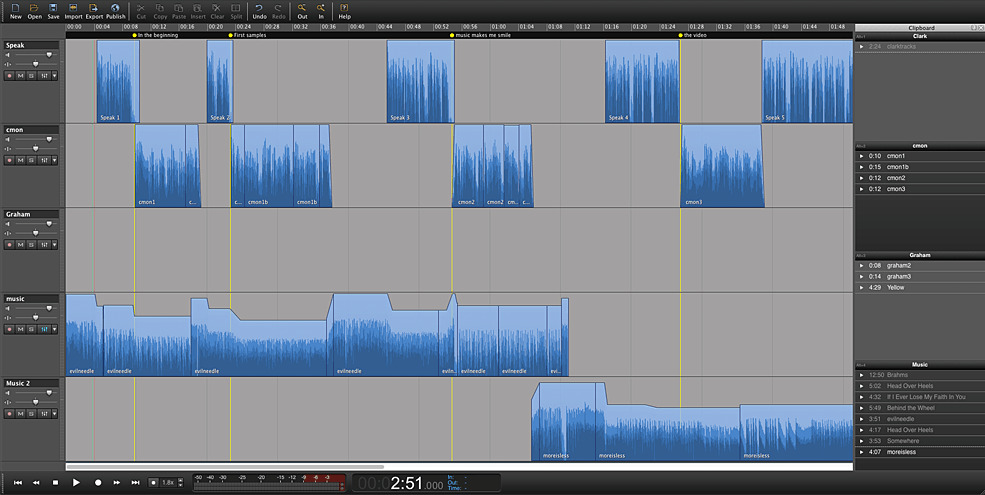
Image from Softpedia.
Compatibility: Windows, Mac
App Store Rating: 4.2/5 (for Field Recorder App)
Audio Restoration Tools: 3.5/5
Price: 30-day free trial, then $399 for a lifetime license or $120/year
Key Features:
- One-Click upload to popular podcast platforms
- Support for many types of audio files
- Cross-compatible with other DAWs
- Noise reduction
Who It’s For
Hindenburg Pro is a podcast editing software made specifically for journalists and podcasters. It has a Clipboard feature to help organize audio tracks and clean up a busy workspace. Our favorite feature is the Music Report, which automatically brings up all the music tracks used in a podcast episode, making paperwork a breeze!
Why We Picked It
Fix common podcasting challenges such as background noise, uneven levels, and bleeding microphones with non-destructive podcast editing. This Hindenburg Pro offers a loudness normalizer with the correct levels for different media standards. It comes with built-in effects and noise reduction tools, but also has third-party plug-in support if you need more than what this podcast editing software offers.
Bottom Line
Hindenburg Pro produces high-quality content and is much easier to use than Audition. It is one of the best podcast software around, but it is aimed more at recording than editing. It has limited effects and noise reduction tools, especially compared to other podcast editing software on our list.
Pros
- High production value
- Uncomplicated and easy-to-use
Cons
- Expensive
- Lacks some advanced effects
11. GarageBand - Best for Mac Users
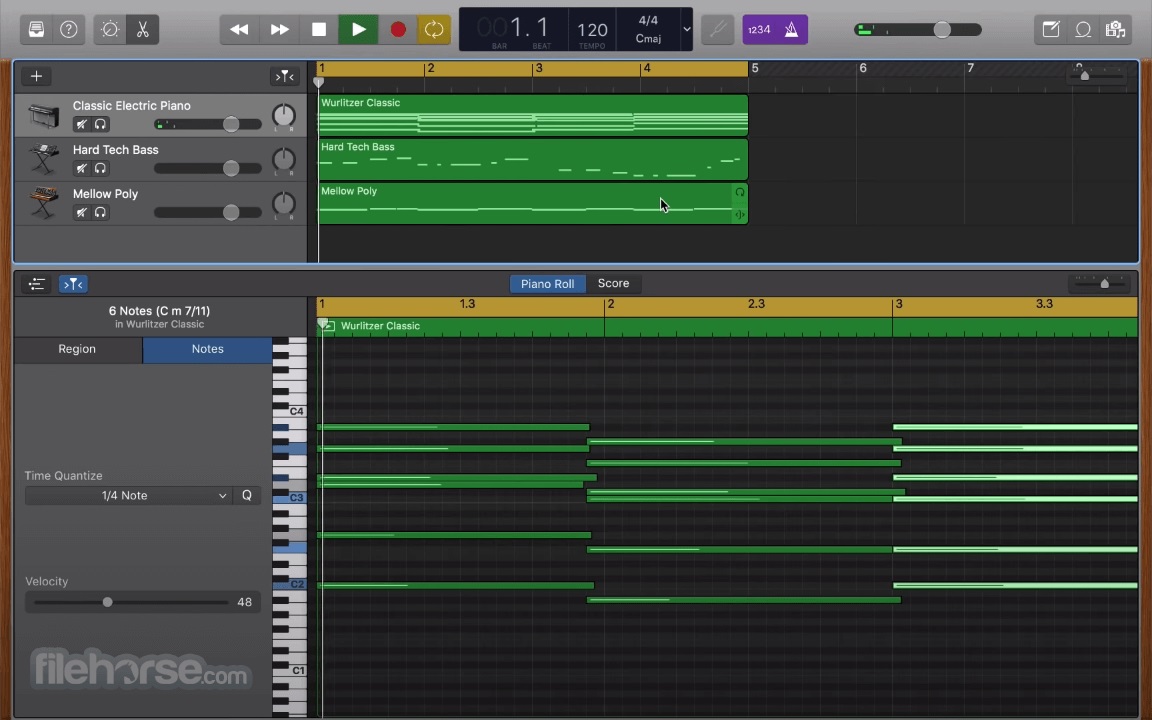
Compatibility: Mac
TrustRadius Rating: 4/5
Audio Restoration Tools: 3.5/5
Price: Free
Key Features:
- Plug-In support
- 225 audio tracks
- Large library of audio effects
- Drag-and-Drop interface
Who It’s For
GarageBand is a music and podcast editing software for beginners and professionals. It is entirely free for Mac users and even has an app to turn your iPhone into a GarageBand remote control. It offers fast performance through Apple Silicon (including M1 Pro and M1 Max) and can be used across all macOS devices.
Why We Picked It
GarageBand has clearly defined, separate audio tracks for easy podcast editing. Label your tracks for the host, guest, intro, music interlude, etc, then use the Solo feature to mute every track but the one you want to edit. This way you can hear which tracks have background noise, coughs, “ums” and more so you can remove them. GarageBand has tons of free music tracks and sound effects you can use to finish off your podcast editing.
Bottom Line
This podcast editing software is often compared to Audacity, because they both are completely free yet offer tons of tools. For Mac users who may be wondering which is better, we think GarageBand is more intuitive, however, Audacity is better suited for podcasts. GarageBand is mostly filled with music production tools, but it does offer audio upscaling tools such as noise reduction, compression, and EQ effect.
Pros
- Large library of sound effects and music to use in your podcast
- Completely free for Mac users
Cons
- Sheer amount of music tools may overwhelm podcast beginners
- Large project files
12. Alitu - Best Podcasting Community
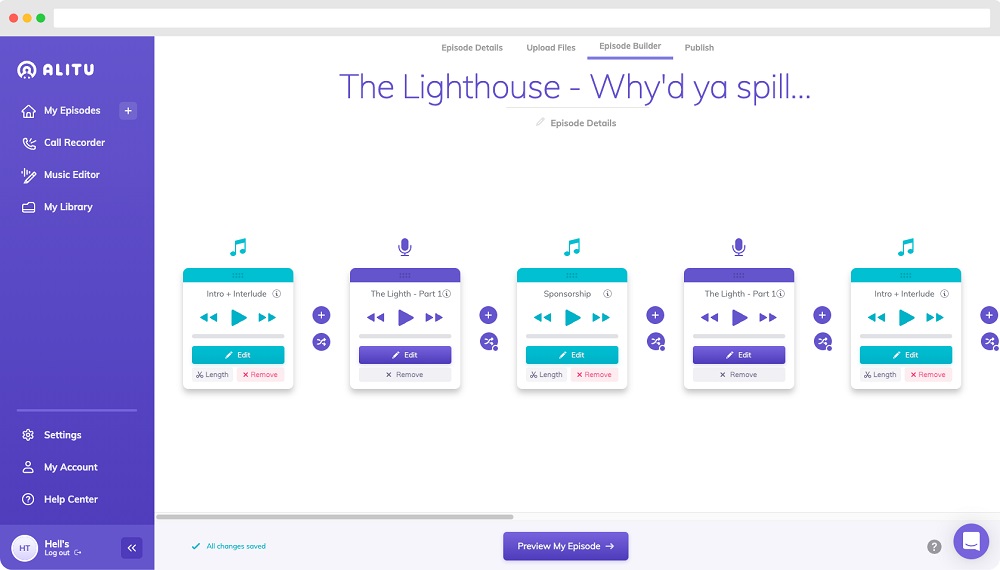
Image from Alitu.
Compatibility: Web Browser
Trustpilot Rating: 4.5/5
Audio Restoration Tools: 3/5
Price: 7-day free trial, then $32/month or $320/year
Key Features:
- Drag and drop interface
- Fade transitions
- Upload directly to podcast host
- Ad break tool
Who It’s For
Alitu is made specifically for podcasters as an all-in-one podcasting solution for those with no experience. We think it’s the best podcast editing software for the community support it regularly offers through live sessions, discussions, and guest exchanges. Alitu also has a Podcast Host Blog, filled with reviews, tutorials, and guides to help new podcasters learn the ropes. This podcast editing software also has an excellent support team for not only answering questions about the software but also podcast questions in general.
Why We Picked It
Manually delete any unwanted audio, then let Alitu automatically remove background noise and adjust volume levels. Complete your podcast editing with the free music library for intros and outros.
Bottom Line
Like Auphonic, this software uses automation to take a lot of grunt work out of the editor’s hands. The site even claims you can edit and upload an episode in 15 minutes. Alitu is not intended for anyone with audio editing experience, because you have no control over noise removal or levels.
Pros
- Lots of personal support
- Clean and unintimidating UI
Cons
- Limited feature set
- No control over audio levels
13. Waveform Free - Best for Professionals on a Budget
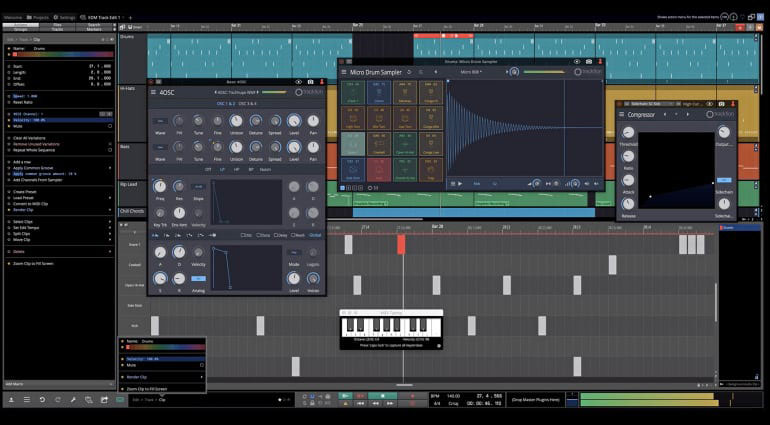
Image from GearNews.
Compatibility: Windows, Mac, Linux
Top Ten Reviews Rating: 4.5/5
Audio Restoration Tools: 2/5
Price: Free
*Pro version available with a 90-day free trial, then $299
Key Features:
- Timecode support
- MIDI editor
- Podcast preset
- Audio ducking
Who It’s For
Waveform Free is the no-cost version of the popular Waveform Pro. This podcast editing software has third-party plug-in functionality and an unlimited track count, so there is potential for a lot more features than meets the eye. Also, even though this version is supposed to be for beginners, the complex layout and functionality make it better suited for people who know what they are doing.
Why We Picked It
Enjoy podcast editing with full automation and a good amount of export options. The interface is customizable so you can change themes, tabs, colors, and more.
Bottom Line
WaveForm Free is one of the most robust free versions on our list, and we love that users can pay for expansion packs without having to purchase the software. However, the packs are all music based, offering little for podcast editing. This podcast editing software is not easy-to-use and lacks automatic audio restoration tools.
Pros
- Unlimited tracks
- Completely free and offers paid expansions
- Generous 90-day free trial
Cons
- Not user-friendly
- Lacks audio restoration
14. Reaper - Best for Podcast Editing Remotely

Compatibility: Windows, Mac, Linux
PCMag Rating: 4/5
Audio Restoration Tools: 2/5
Price: 60-day free trial, then $60 for a discounted license (personal use, businesses that make under $20,000/year, schools, and nonprofits) or $225 for a commercial license
Key Features:
- 64-bit internal audio processing
- Support for third-party plug-ins and extensions
- Apply effects in real-time
- Multichannel support
Who It’s For
Reaper is an entirely portable DAW that runs from a USB and doesn’t require installation on your computer. Great for journalists who need to edit quickly from their recording location, podcasters who like to do their editing on the go, or those who do their podcast editing on multiple devices.
Why We Picked It
You can drag and drop to import, arrange, and render audio files. With this podcast editing software, you can perform time stretches, pitch shifts, crossfades, and more without switching tools. Reaper’s nested folder system allows for batch editing, routing, and bussing.
Bottom Line
We found this podcast editing software to be full of advanced audio mixing features, but most of its tools are geared toward the music industry. Reaper lacks any podcast-specific tools like templates, audio-restoration tools, or sound effects. It’s also far too intimidating for beginners. If you aren’t a musician, try software for podcast editing like AudioDirector or Hindenburg Pro.
Pros
- Lightweight, nothing to install
- Customizable layout
- Generous 60-day free trial
Cons
- Difficult plug-in integration
- Not for beginners
- No podcast presets or templates
15. Fission - Best for Lossless Podcast Editing

Compatibility: Mac
MacUpdate Rating: 4/5
Audio Restoration Tools: 1/5
Price: Free trial, then $35
Key Features:
- Normalize function
- Direct upload to SoundCloud
- Batch file conversion
- Edit metadata
Who It’s For
Fission is a podcast editing software for anyone who needs to make quick, simple cuts to their audio. Fission’s main goal is to allow users to quickly edit MP3, AAC, FLAC, AIFF, Apple Lossless, and WAV formats with zero loss in quality. Divide podcasts into chapters or merge, fade, or chop audio without affecting the sound quality of your files.
Why We Picked It
This podcast editing software is quick and easy to use. We like it best for its cropping and trimming tools. Fission offers one-click solutions to remove unwanted audio in a snap. It will also automatically split files based on silence and offers cue sheet support.
Bottom Line
With Fission, you don’t need to worry about losing audio quality during podcast editing. But while it keeps your recordings intact, it offers very little to elevate audio, besides tweaking gain. If you record podcasts in a studio, and simply need a tool to quickly trim, split, and remove audio, then give Fission a try. If you don’t have the luxury of a recording studio, look for podcast editing software with better audio restoration tools, such as AudioDirector.
Pros
- Simple podcast editing
- Affordable
- AudioHijack, SoundCloud and Apple Music integration
Cons
- Limited tool set
- No background noise removal
Best Free Podcast Editing Software Comparison Chart
| Software | OS | Beginner-friendly | Audio Restoration Tools | Batch Processing | Free Music/Sound Effects Library |
|---|---|---|---|---|---|
| AudioDirector | Windows | Yes | Wind removal, reduce noise, plosive removal, hiss and hum removal, distortion removal, and contour dialogue | Yes | Yes |
| WavePad | Windows, Mac | Yes | Noise reduction, click/pop removal | Yes | Yes |
| GoldWave | Windows | Yes | Noise reduction, click/pop filter | Yes | No |
| Adobe Audition | Windows, Mac | No | Remove beeps, hisses, and other unwanted noises | No | Just sound effects |
| Podcastle | Web Browser | Yes | Background noise removal, echo and noise cancellation, fix plosives | No | Yes |
| Sound Forge Pro | Windows | No | De-click, de-clip, de-hum and de-noise | Yes | No |
| Descript | Web Browser | Yes | Minimal | Yes | No |
| Audacity | Windows, Mac, Linux | Yes | Noise reduction, reduce and isolate vocals | No | No |
| Auphonic | Web Browser | Yes | Noise and hum reduction | No | No |
| Hindenburg Pro | Windows, Mac | Yes | Noise reduction, fix bleed | No | No |
| GarageBand | Mac | Yes | Noise reduction, compression, and EQ adjustment | No | Yes |
| Alitu | Web Browser | Yes | Remove background noise | No | Just music |
| Waveform Free | Windows, Mac, Linux | No | Minimal | No | No |
| Reaper | Windows, Mac, Linux | No | Minimal | No | No |
| Fission | Mac | Yes | Minimal | Yes | No |
How to Edit a Podcast
Here is a step-by-step guide to reducing noise with the best free podcast software, AudioDirector.
Click the link to download AudioDirector for free, import your audio into the program, then follow along:
- Click Edit, then Noise Reduction.
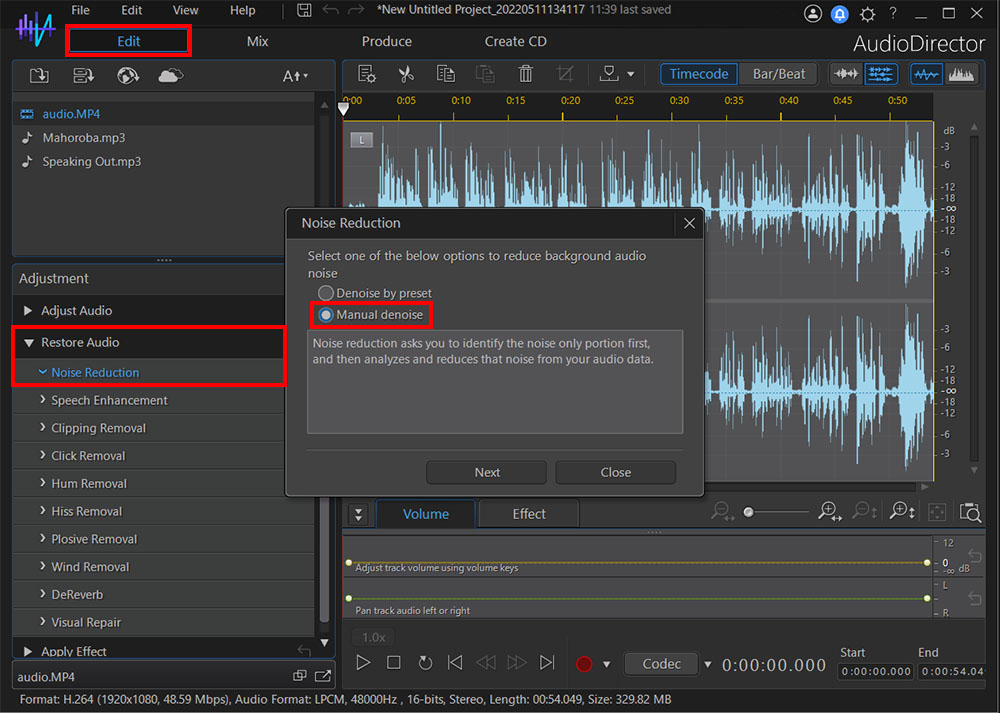
- Choose Manual Denoise.
- Click Analyze.
- Adjust the Sensitivity, Noise Reduction Level, and Dry-Wet Mix with the sliders provided.
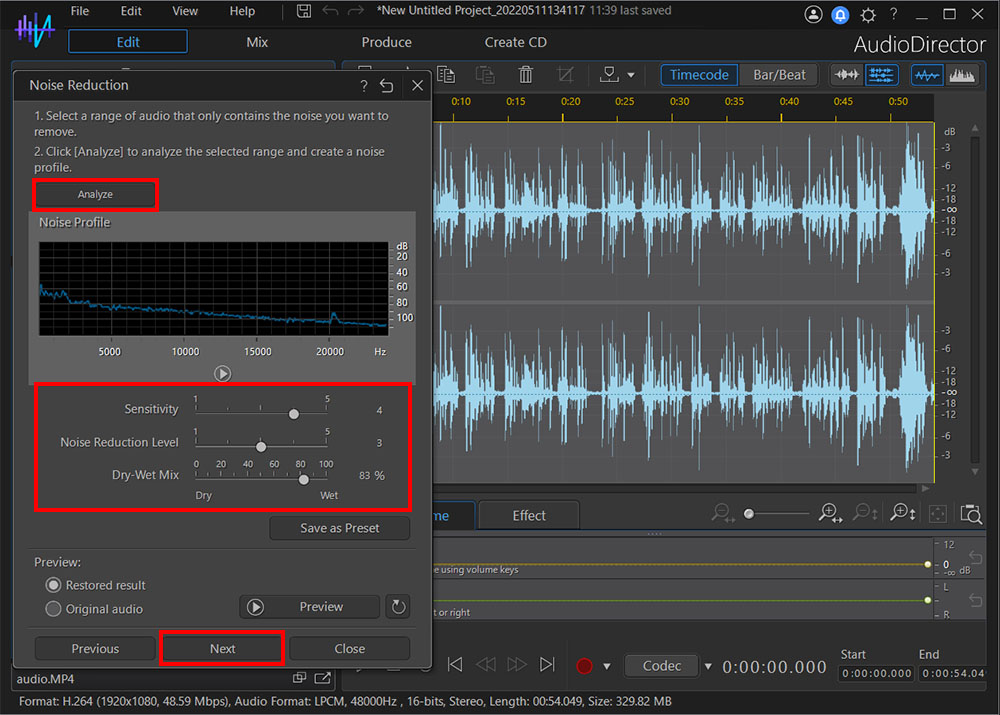
- Click Preview to hear your audio with the changes. If you are happy with it, click Save as Preset.
- Click Next, then Apply to save.
Check out more AudioDirector tutorials by clicking here.
Download the Best Podcast Editing Software for Free
No matter how great your podcast content is, don’t let it be skippable due to bad audio quality. Inaudible conversations or distracting background noises can make a difference in your success as a podcaster. This is why we recommend AudioDirector as the best podcast editing software. AudioDirector was the only tool for podcast editing on our list to offer robust audio repairing tools, noise reduction, fast rendering, and free music and sound effects to add a professional touch to your podcast. It is a powerful digital audio workstation that lets you perform high-quality podcast editing at an affordable price.
To remain cost-effective, you can also bundle your podcast editing software with a Director Suite 365 subscription. Director Suite 365 also comes with PowerDirector, award-winning video editing software, making this a great option for YouTubers who may want to provide video versions of their podcasts. Also included is the photo editing software PhotoDirector, which can come in handy for creating social media posts, thumbnails, logos, and other important podcast assets.
Director Suite 365 is the best price/performance ratio for podcast distribution. Download AudioDirector or Director Suite 365 today by clicking the links below. You will be impressed by what you can create.
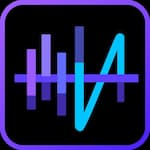

Free Podcast Editing Software FAQ
The top ten features you should look for in podcast editing software are
- Noise reduction
- Hiss and hum removal
- Plosive removal
- AI-powered tools
- Free music library
- Free sound effects
- Batch processing
- Effect combos
- Voice removal
- Vocal balance
If you’re looking for podcast editing software that checks all these boxes, we recommend AudioDirector.
You can use any of the software on this list for podcast editing. We recommend our top pick, AudioDirector, because it has advanced tools that are easy enough for beginners, and AI-powered audio restoration tools to repair, restore, and upscale your recordings.
The best podcast editing software is AudioDirector. With AudioDirector, you can create high-quality audio for your podcast, even in noisy environments. Enhance speech and remove background noise, distortion, wind, plosives, and so much more. It also comes with royalty-free music, sound effects, and easy-to-use audio editing tools. Add to that recording capability, and you have everything you need for professional podcast creation in one package.
All of the options on our list are either completely free, offer a free trial, or have a free version of their paid software you can use for podcast editing. We recommend AudioDirector, because it is the only one to offer a completely free forever version, plus a 30-day free trial of all its premium features, and it has the most affordable paid version of any podcast editing software on our list.
The first step in podcast editing is deciding how long your episodes should be. Then you can cut and trim audio with that goal in mind. Trim out any parts that ramble or don’t go with the arc of the episode. You can also trim silences, low-quality audio, and any mess-ups or repeats. Anytime you make a cut, listen back to make sure the conversation naturally flows, and you haven’t deleted information that comes up later.
Once you have all the audio you wish to keep, mix the levels so all the sound is even. If one guest speaks much louder than everyone else, lower the volume on their audio track. Then use audio restoration tools to fix any poor-quality audio that had to stay.
Next, sound design your podcast by adding sound effects or music tracks, if the situation calls for it.
Finally, add in your intros, outros, and any ad breaks.
The price for podcast editing varies greatly depending on where you look. A subscription site such as Podcast Monkey will cost $399/month for 2 episodes, $799/month for 4 episodes, and $1,499 for 8 episodes. If you hire an independent editor from a site such as Fiverr, you can find people to edit your podcast for around $25 - $100 for 15 minutes.
The Joe Rogan Experience podcast uses a dual-monitor MacBook Pro setup (32″ Apple Pro Display XDR monitors) with Blackmagic Design ATEM software for the video portion of the podcast, and Apple’s Logic Pro for the audio.
Logic Pro is Apple’s professional step-up from its free GarageBand software and costs $200.
It depends on how many guests you have, how much the audio needs to be trimmed or cleaned, and how long the raw footage is.
A good rule of thumb is about 3-5 minutes for every minute of the podcast, so roughly 3-5 hours. This time includes listening back to the entire episode to make sure it flows and you didn’t miss anything. This means you should be able to edit 2 60-minute podcasts per workday.
That depends on your podcast editing software. If you use an intuitive, beginner-friendly program like AudioDirector, then podcast editing can be easy.
Podcast editing is easier than video editing because you only need to worry about the audio and not the visuals. It’s also easier to edit a podcast than to edit music tracks, which requires a lot more expertise.
It takes about 3-5 minutes per minute of the podcast, so 90 minutes - 2.5 hours.
You could post a podcast that hasn’t been edited, but it wouldn’t sound very professional.
With the right podcast editing software, you can make a world of difference with very little editing. In fact, the Joe Rogan Experience does very little editing before posting their podcast. Of course, they have professional equipment, a recording studio, and a seasoned host, so they don’t need as much editing as other podcasts.
There are a lot of factors that determine how much editing your podcast might need, but it’s always a good idea to do at least a small amount of editing before you post.
Clean up podcast audio using AudioDirector’s precision restoration tools. These tools will allow you to remove noise, hiss, hum, or distortion. You can also enhance speech, remove wind, and control reverb and echo.
See above for a step-by-step tutorial on using AudioDirector’s noise reduction tool.
Successful podcasters can charge for ads based on the cost per thousand impressions, or CPM. CPM can range from $20 to $100 per 1,000 listeners.
Technically, one person can set up, record, edit, and post a podcast. However, having at least one person to bounce ideas off of is a good idea. It’s also more appealing for the listener to hear a conversation between 2 or more people instead of a monologue. A solo performance podcast only works if the person is an expert on something, and it would be hard to get multiple episodes out of one person’s knowledge of a topic.




